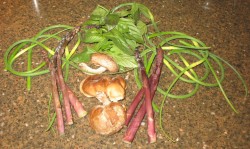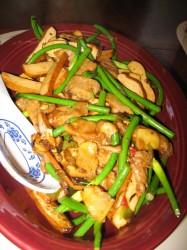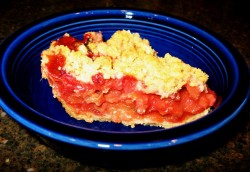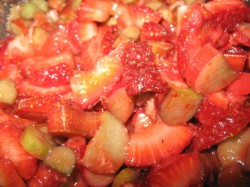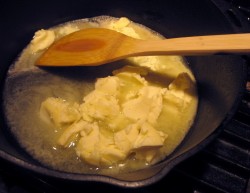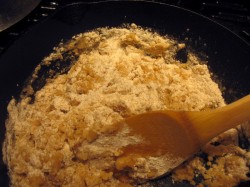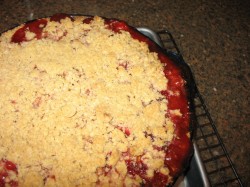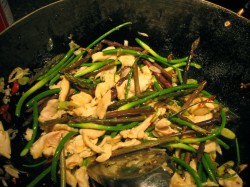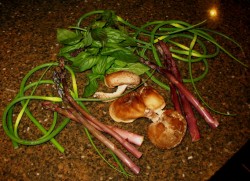The Spice is Right III: A Reminder
This is just a quick reminder that the deadline for The Spice is Right III: “The Perfumed Garden” is coming up on June 15th!
I have recieved a few very lovely entries already, and I hope to hear from a few more folks who are willing to mix the flavors of edible flowers with spices in an adventurous bout of cooking and blogging.
I look forward to hearing from more bloggers; as always, if you have any questions, post them, or email me and I will be happy to help you out!
Happy cooking!
The Great Scape (Garlic, That Is….)
Cooking locally is a challenge to some; to me, it is just good, honest fun.
When I combine cooking locally with blogging, everything just gets that much more fun, because I get ideas from other bloggers and from commenters on my blog on recipes to use my newly-found farmers market treasures.
Take garlic scapes, for example.
Shirley, from Singapore, commented that she likes to cook them with pork and pressed tofu.
That sounded right fine and tasty to me, so last night, I had some pork I could thaw out and some pressed tofu in the fridge, so lo and behold, guess what we had for dinner?
Pork and Pressed Tofu with Garlic Scapes.
Cooking it was wonderfully fun, but eating it was even better, because I learned a few more things about garlic scapes.
First of all, the very young, new scapes, like I had last week, are very mild and somewhat sweet, with a very “green” flavor in addition to the gentle garlic taste.
I discovered last night, however, that the older scapes, like I had this week, are a bit tougher and more fiberous (so much so that I could have blanched them a little before stir-frying them) and in addition, the green flavor is overpowered by the strong tang of garlic. In fact, the garlic flavor was so strong in some of them, that they were postively HOT! It was a very good thing that I went easier on the chile peppers than I at first intended to, as many of the scapes themselves were full of enough fire and fury for most palates!
I enjoyed them, however, and they tasted great with the lightly five-spice flavored pressed tofu and the pork.
The sauce was simple, and I was happy of that; I just used some premium Chinese soy sauce, a scant teaspoon of raw sugar and a goodly splash or two of Shao hsing wine. Any more flavors would have competed with the stronger flavor of the garlic scapes and would have muddied the dish. I nearlly added fermented black beans, but left them out at the last minute, and rightly so.
I finished it off with a tiny drizzle of toasted sesame oil, and with the aromatics of some very fresh local scallions, some garlic, ginger and chiles, the entire dish came together as an enticement that really called for us to eat plenty of rice to soak up the strong, clean flavors.
Next time I make this, however, I will taste a garlic scape on its own; while the older one still have much of the texture of green beans or Chinese long beans (hrm–I wonder if they can be dry fried?), they are a bit tougher than I would necessarily like. Blanching would not only soften them up a bit, but would also tone down the intense garlic heat of them as well, and would probably make for a more balanced dish overall.
So, if you have garlic scapes to use up, taste them first, and then decide whether or not you want to blanch them before you try them in any of the recipes I have given here for them! After you have made that decision–get to cooking them–they are a valuable addition to the flavors of late spring and early summer.
I really cannot imagine not having these odd and lovely vegetables again next year, when they are in season again.
Shirley’s Pork, Pressed Tofu and Garlic Scape Stir-Fry
Ingredients:
1/2 pound boneless lean pork loin, sliced thinly
3 teaspoons of premium soy sauce (I use Kimlan Premium Aged)
4 teaspoons cornstarch
4 tablespoons peanut or canola oil
3 large scallions, white and light green parts only, thinly sliced on the bias
3 cloves garlic, peeled and thinly sliced
1/2″ cube ginger, peeled and thinly sliced
1 serrano or similar red chile, thinly sliced on the bias
1 teaspoon raw sugar
3 fresh or dried (and rehydrated) shiitake mushrooms, stems removed, thinly sliced
8 ounces pressed spiced tofu, thinly sliced on the bias
1 tablespoon soy sauce
3-4 tablespoons Shao hsing wine
1 1/2 cups trimmed garlic scapes cut into 2″ long pieces
1/4 teaspoon toasted sesame oil
Method:
Mix together pork, soy sauce and cornstarch and allow to marinate 20 minutes to one hour.
Heat wok until it is smoking hot, then add peanut or canola oil. Allow to heat until oil shimmers.
Add sliced scallions, garlic, ginger and chile, and stir fry until very fragrant–about one minute.
Add meat, carefully layering it into a single layer on the bottom of the wok. Allow to remain undisturbed for about a minute, so that it may brown on the bottom. While this is going on, sprinkle sugar evenly over the top side of the meat.
When the pork smells browned, begin stir-frying. Add mushrooms and tofu, and stir fry until the pork is nearly done–3/4 of the pink color should be gone.
Deglaze the brown marinade that is stuck to the wok with the wine and soy sauce, scraping up all of the browned bits. Add the garlic scapes and stir fry until all of the meat is done, and the garlic scapes turn a deep, rich green, and the sauce is thick, glossy and clings to every bit of the food.
Take off the heat and drizzle with the sesame oil.
Scrape from wok into heated serving dish and serve immediately with steamed rice.
First Pie of the Season: Strawberry Rhubarb Crumble Pie
I know that last month, I promised as the strawberries came into season, to write about a bunch of recipes that used them while they were at their peak of flavor and freshness.
And did I do that?
No.
Why?
Because I was too busy eating them up to cook with them.
They just tasted way, way too good eaten out of hand, or perhaps dipped in slightly sweetened sour cream, to bother cooking with them. I haven’t even made strawberry shortcake yet! Or strawberry ice cream. Or, well, anything.
Until last night. I had about a quart and a half of strawberries and a pound of rhubarb in the fridge that needed to be used, so after supper, I rolled up my sleeves and prepared to make pie.
Except–I have never, ever made a strawberry rhubarb pie. I know it is a classic combination of late spring and early summer fruits, but I still had never tasted it. I am not certain why, except that no one in my family much liked rhubarb except my Grandpa. Apparently, he hadn’t grown it in years, either, by the time I came into pie-eating age, so there we are. Never once did I eat it, until today.
I have to say this–rhubarb stalks are very, very pretty. Ranging in color from celery green to ruby red, the smooth stalks glint with the hues of the semi-precious gemstone watermelon tourmaline. It is simple to work with, requiring no peeling, only cutting off the dried out ends from the stalks and trimming any leaf bits that may be left; the leaves are toxic and will sicken a person if they eat them. After that, all that remains to be done is to slice the stalks into 1/4″ pieces, and they are ready to be made into pie filling.
The strawberries have to be rinsed, hulled and sliced, and then, into the bowl they go with the rhubarb. I used roughly twice as much rhubarb as strawberries, as I was following a recipe from Ken Haedrich’s book, Pie.
Were it left up to me, I probably would have added more strawberries out of ingorance of the refreshing sour flavor of the rhubarb. But, I am glad I vaguely followed the instructions for the filling and left the proportion of strawberry to rhubarb essentially as written. I did use a few more strawberries than were called for; but that is because I wanted to use them up.
But, you know me–I could not leave the recipe completely as written; I had to tweak it a little. So, I did add the zest of a lemon and two tablespoons of rosewater to the filling mixture to grand effect, if I do say so myself. The rosewater adds a little extra “oomph” to the filling without being obviously floral, while the lemon zest adds complexity and melts beautifully into the cardamom and ginger that Haedrich’s source for the recipe, Dolores, used.
The crust was an unusual one–it is a “skillet crust.” Made by melting butter in a skillet, and then mixing in vanilla extract, and then stirring in flour and sugar until it forms uniform crumbs, the crust was simple to prepare, and a snap to use. Two thirds of it were pressed into the bottom and up the sides of a deep dish pie pan, while the rest was reserved to make a crumb topping. It was as simple to prepare as a graham cracker crust, but required no pre-baking; and I have to admit that it smelled really nice coming together.
I was at first dismayed by the amount of sugar in the crust, but after tasting it, the shortbread like consistency and flavor really offset the tang of the filling. Dolores really knew what she was on about when she made that crust recipe.
All in all, it turned out beautifully, and the pie comes out with a crisp crust and topping, filled to bursting with juicy, tangy fruit. It is a lovely dessert, and I will not hesitate to make it again–besides, I feel as if I must make up for all of those years I never tasted rhubarb! The spices are used in small enough amounts not to overpower the fruit and the rosewater really brings out the flowery nature of strawberries.
Strawberry and Rhubarb Crumb Pie in a Skillet Crust
For the Crust:
2 1/4 cups all-purpose flour
1 cup sugar (I used raw cane sugar)
3/4 cup butter
1 teaspoon vanilla extract
Method:
Combine the flour and sugar in a bowl and set aside.
Melt the butter in a large skillet over medium heat; when it is melted, blend in the vanilla.
Turn off the heat and stir in the flour and sugar mixture; this may take some time, but be patient and keep stirring until you have a pan full of evenly mixed crumbles.
Transfer about two thirds of the crumbs to a 9 1/2 inch deep dish pie pan, and press them to the bottom and up the sides of the pan.
Preheat oven to 350 degrees F.
Ingredients For the Filling:
1 1/2 pounds fresh rhubarb stalks, trimmed of leaves and sliced crosswise 1/4 inch thick (They should come out to be about 4 cups of slices)
2 cups hulled and sliced fresh strawberries
3/4 cup sugar (I used raw cane sugar)
zest and juice of one lemon
1/4- 1/2 all purpose flour (if your rhubarb stalks are small, use the larger amount of flour–if they are large, they are drier, use the smaller amount of flour)
1/2 teaspoon ground cardamom
1/2 teaspoon ground ginger
1-2 tablespoons rosewater (use smaller amount for a more subtle effect)
Method:
Mix together the filling ingredients and allow to stand for ten minutes.
When the oven is preheated, put the filling ingredients into the prepared bottom crust and level it carefully. Crumble the reserved crust mixture over the pie evenly, and press it down gently with your hand.
Place the pie in the center oven rack and bake for thirty minutes. Turn the pie 180 degress and turn the heat down to 325 degrees F. Close the oven and bake for another 40-50 minutes, until the topping is golden brown and the juces bubble thickly up around the edges of the crust.
Remove from oven, and allow to cool at least two hours before serving. (This is important–the filling thickens up as it cools. If you try to cut into it before it is at least just barely warm, it will be a sloppy, messy, painful procedure, and your pie will look more like roadkill than dessert.) (Although, for those with a morbid sense of humor, “Roadkill Pie” does have a sort of ring to it.)
The Issue of Eating Locally Appears in This Week’s Time Magazine (With Quotes From Yours Truly…)
The current issue of Time Magazine, which just came out this morning, contains a lot of really neat articles about food, eating, health, family meals pasture-raised beef, and eating locally. For regular readers of this blog, the topics covered by Time in this series of articles makes it something worth looking into, and I highly recommend picking up a copy the next time you are at your local bookstore, newstand or grocery store.
One of the articles, “The Lure of the 100-Mile Diet” is about eating locally, and while it didn’t come out during the month of May, eating locally isn’t something that should be talked about just one month of the year, during the Eat Local Challenge. It is an enduring concern of those of us who want to support more sustainable methods and means of agriculture.
Now that the article is done and out, I can ‘fess up to having been contacted by the reporter who wrote the story, and being interviewed. Margot Roosevelt asked very probing, thought-provoking questions, and I was very happy with her treatment of the subject, which because of the print space she was allotted, was concise, but very thorough and not shallow.
While it doesn’t appear in the online version of the article, a photograph of me was taken by a Time photographer to add to the print story; as I have not had a chance to run out and pick up a copy, I do not know if it actually made it into the issue. But, if it did, and if everyone is terribly curious about what I look like–you can pick up a copy of this week’s Time and find out!
I won’t talk about the experience of the photo session just yet, because I want to highlight the other interesting articles in Time this week right now. Later, I’ll talk about how it felt to be photographed and interviewed by folks from one of the premier news magazines out there.
So, what other fascinating articles are in Time this time around?
Michael Pollan, author of the book, The Omnivore’s Dilemma, presents “Six Rules For Eating Wisely,” which includes the sage advice, “Don’t eat anything your great-great-great grandmother wouldn’t recognize as food.” Amen to that!
“The Magic of the Family Meal” takes up the issue I have talked about many times in this blog–why family meals are good for kids and parents, while Margot Roosevelt takes on “The Grassfed Revolution,” and talks about why pasture-raised beef is better for the cows, the diners and the environment. In “Rethinking First Foods,” reporter Pamela Paul looks into the issue of what are the best first solid foods for babies to eat in order to help promote healthy eating habits for the future.
Amanda Bower looks at two communities and how they managed to change school lunches from bastions of fat, salt and sugar into nutritional powerhouses loaded with fresh food while getting the kids to eat and like the new foods in “Retooling School Lunch.”
Another issue that I have been ruminating on for years, is the question of why some diets and nutrients work better for some people more than others, is covered by “Does My Diet Fit My Genes?”, while “Catering to the Melting Pot” shows how chain restaurant The Cheesecake Factory has strongly influenced the way that Americans eat and has introduced ethnic foods to the mainstream.
“How Sweet it Isn’t” takes on sugar substitutes and why they aren’t necessarily making Americans thinner, while “2 Thin Chefs” examines why Giada De Laurentis and Suzanne Goin, while they are surrounded by temptation every day, still manage to remain “vanishingly thin.”
There is even more in the issue that are related to food, eating and health, but I think I gave you the major highlights. I think it that it is really worth running out and picking up a copy, and not just because my fifteen minutes of fame are contained therein!
What To Do With Garlic Scapes And Purple Asparagus
One of the most exciting things about shopping at the farmers market is finding something new and interesting to cook that I have never tasted before.
And the farmers who sell at the Athens Farmers Market are so very much into diversity, experimentation and growing new and interesting plants, that there is seldom a week that goes by that I don’t find something I haven’t yet tried, beckoning to me from one of the baskets, crates, or tables.
This week, two lovelies called to me, and begged for me to give them a whirl: garlic scapes and purple asparagus.
What are garlic scapes?
Well, they are the flowering stalk of hardneck garlic, and they grow up out of the plant in gorgeous loops and whorls of vibrant green. Many people cut them off and compost them, but they are good to eat, and so there is a farmer here in Athens who sells bags of them for a very low price.
I had no idea what to expect from them, but they looked so beautiful, with graceful curves ending in a pointed flower bud with a long trailing tip. They are reminiscent of the recurve of a swan’s neck, so I just could not leave them alone.
The other beautiful find was purple asparagus.
First of all, it is asparagus, which I thought we had seen the last of for the year (I was never so happy to be wrong!), and secondly, it is an amazing red-violet color shaded with burgundy and green. Looking at it, I wanted a dress in those colors, made with silk velvet. Lacking that, I had to have the asparagus.
Of course, there is a downside–the purple color does not stay once it is cooked. The anthocyanin, which is the pigment that gives blue potatoes, red cabbage and purple asparagus their vibrant colors, does not survive heat well. So, why buy purple asparagus in the first place?
Well, because it is pretty, of course! And, besides, if you cook the asparagus with an acidic component, some of the pigment can be coaxed to stay–just as one adds vinegar or lemon juice to red cabbage as it cooks to make a brilliant colored sweet and sour cabbage, one can add lime juice to purple asparagus and get some of the lovely violet to stay intact.
It was the lime juice (I had no lemons) and the fact that I had Thai basil that made me decide what to do with my garlic scapes, purple asparagus and fresh shiitake mushrooms: yet another variant on Spicy Thai Basil Chicken.
(The fact that I had chicken thawed out that needed using also played a part in this decision.)
I used the garlic scapes and asparagus as I would use green beans, and cooked the sliced mushrooms along with the chicken. Instead of using shallots in the recipe, I used local scallions, and the garlic I used was also local, fresh hardneck garlic. I used soem of the last few Thai dragon chiles from last fall that have been in the freezer, and have been heating up my cooking all winter long; in fact, the local ingredients in this dish outweighed the non-local ones. The ounce of lime juice, few tablespoons of peanut oil, several tablespoons of fish sauce and oyster sauce, were all that I used that did not come from Athens county.
How did it taste?
I think that this combination of vegetables in the basic Thai Spicy Basil Chicken recipe was my favorite. The garlic scapes were amazing–they had the texture of Chinese long beans, and a bit of a green-beanish flavor, owing to the “greenness” of them. But they also tasted wonderfully and mildly of garlic, but no overpoweringly so. The asparagus, of course, was delicious–the same wonderful springtime delicacy that we know and love, but with the added beauty of being emerald green tinged with deep amethyst colors. The mushrooms soaked up the flavor and heat of the sauce and were silky on the palate–eminently slurpable.
And of course, the basil tied it all together.
All in all, it was a wonderful supper.
So–if you find some garlic scapes and purple asparagus in your neighborhood–do take them home and cook them. Treat the garlic scapes as green beans in a recipe and see what happens, and try cooking your asparagus with a bit of lemon, lime or vinegar, and see how purple you can keep it. The flavors are worth it and of course, there is the distinct pleasure of working with something new, pretty and strange.
Cooking can be such an adventure!
Powered by WordPress. Graphics by Zak Kramer.
Design update by Daniel Trout.
Entries and comments feeds.


